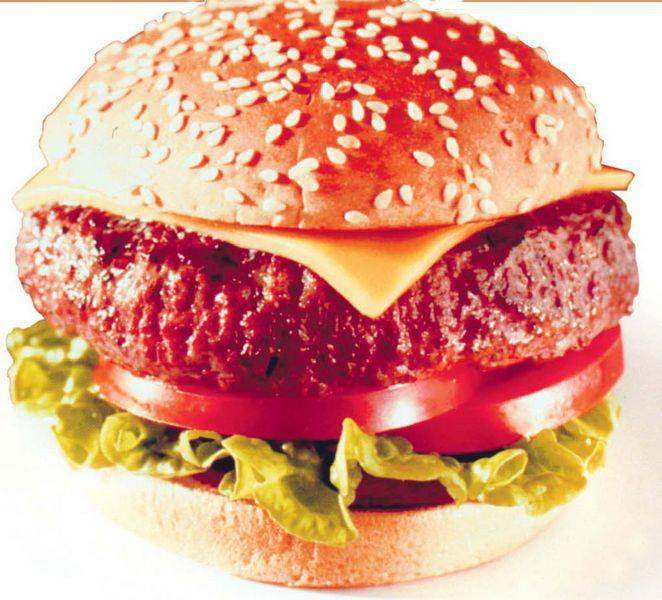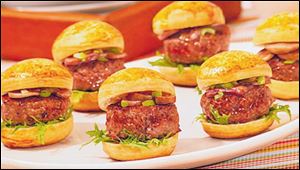
Burger basics: Food safety, delicious combinations make for healthy grilling
7/1/2008
The classic cheeseburger.

The classic cheeseburger.
Despite the recent E. coli scare involving some ground beef, it s still possible to have a safe and savory experience when grilling burgers this holiday weekend, no matter what recipe you use to make them.
From a Classic Beef Cheeseburger to a Caribbean Burger with Honey Pineapple Chutney, there s a world of recipes that use different ground meats and spice combinations as well as toppings. (The Caribbean Burger s pineapple chutney is good enough to eat on its own.)
Just as popular are the sliders or mini-burgers that are great for appetizers for summer entertaining. For the low-carb appetite, an Asian Chopped Steak is a new take on burgers served with a Wasabi-Mayo dressing on the slaw: there s no bun or bread with this entree.
The traditional burger is made from ground beef, which is the result of trimming steaks and roasts so the ground beef contains a variety of cuts from the cow including everything from chuck to filet mignon, according to Johnson & Wales University chef instructor Alan Lazar based at the North Miami campus in Florida.
Meat markets and supermarkets sell ground round, ground sirloin, ground chuck, and lean ground beef. Round and sirloin beef come from the back of the cow and may be considered dry compared to chuck which comes from the neck and shoulder areas and has good fat content. Mr. Lazar thinks that chuck makes the best hamburgers because it is the right amount of fat to hold the meat together and provide moisture and flavor.
Burgers made from chicken, turkey, pork, and veal may provide variety in taste, but the amount of water in the meat may make a difference. According to Mr. Lazar, these types have a higher water content, which means it s less likely the burger will stay together.
If you ask the butcher to grind meat, ask for a 80:20 lean to fat ratio to be made with a small to medium grind. The larger the grind, the tougher the meat will be to chew. Grinding the meat cuts the myofibril muscles and mixes the fat to make it more palatable.
Start with the freshest ground beef, pork, chicken, turkey, veal, or lamb that you can buy for burgers. Choose packages that are cold and tightly wrapped without tears and punctures. Check the sell by date on the package label. Purchase before or on the date printed. Then use the ground beef within 24 hours.
A bright cherry red color indicate fresh ground beef. Fresh ground beef goes through color changes during its shelf life. A darker, purplish-red color is typical of vacuum-packaged ground beef or the interior of ground beef which has not been exposed to oxygen; once exposed to oxygen, the beef turns to dark red and then red. With extended exposure to oxygen, the red color will take on a brown color. These changes are normal.
If you find you can t use the ground beef within 24 hours, shape it in patties and freeze it with freezer paper between each pattie and wrapped in freezer paper or freezer bags.
Fresh ground meat makes the best burgers, but if you have to use frozen ground beef or meat, defrost in the refrigerator to prevent bacterial growth. Allow 24 hours to defrost a 1 to 1 -inch package. Never refreeze defrosted ground beef, advises the Ohio Beef Council. Cook ground beef as soon as possible after thawing. Cook without interruption; partial cooking may encourage bacterial growth before cooking is complete.
Cook until desired doneness without interruption.
Wash hands before and after handling raw ground beef as well as work surface and utensils after coming in contact with raw ground beef.
To cook 4 ounce beef patties (not frozen), -inch thick:
Grill on an open grill using direct heat over medium coals for 10 to 12 minutes, turning once halfway through cooking.
Broil on a rack in broiler pan so the surface of the meat is 3 to 4 inches from heat. Broil 10 minutes, turning halfway through cooking.
Or pan broil in a preheated heavy skillet over medium to medium-low heat 7 to 8 minutes, turning once halfway through cooking.
Avoid continually flipping the burger.

These sliders are two-bite treats that are simple to prepare.
The secret of cooking ground beef and hamburgers is to grill ground beef to at least medium 160 degrees doneness, advises the Ohio Beef Council. Use a meat thermometer to check the internal temperature. Make sure your thermometer is designed for meat and poultry. Instant read thermometers that have a dial or a digital readout give accurate information quicker.
Insert the meat thermometer into the deepest part of the food. Check cooked ground beef in several places to get an accurate reading. Wash your thermometer in hot soapy water between testings. Do not put a thermometer in the dishwasher.
Chow Line, an Internet publication from the Ohio State University, recommends safe minimal temperatures of 165 degrees for poultry; 160 for beef hamburgers and all cuts of pork; and beef, lamb, veal steaks, roasts and chops should be cooked to 145 degrees for medium rare or 160 degrees for medium.
There are so many ways to build a burger. A Blue Moon Burger is a grilled burger topped with Bleu cheese, sauteed mushrooms, lettuce and tomato served on an onion bun.
A Spicy Burger has jack cheese melted on a lean ground beef patty with jalapeno peppers and onions. A Gouda Burger has sliced cheese and grilled zucchini atop a grilled hamburger.
Or you can make your own version. One of your creations could be a winner in the Sutter Home Winery Build a Better Burger National Contest and Cook-Off. Entries are accepted through April 18. For contest entry rules, visit www.sutterhome.com. Ten finalists will be flown to the Napa Valley to compete in a burger grilling cook-off on Sept. 27 which will be judged by a panel of chefs and food industry experts.
Cookbook author Sally Sampson has 52 recipes in Recipe of the Week: Burgers (Wiley, $16.95). This includes Cuban Style Pork Burgers, Lamb Burgers with Herbs, Portobello Burger, and Turkey Burgers with Indian Spices.
Kathie Smith is The Blade s food editor. Contact her at food@theblade.com or 419-724-6155.